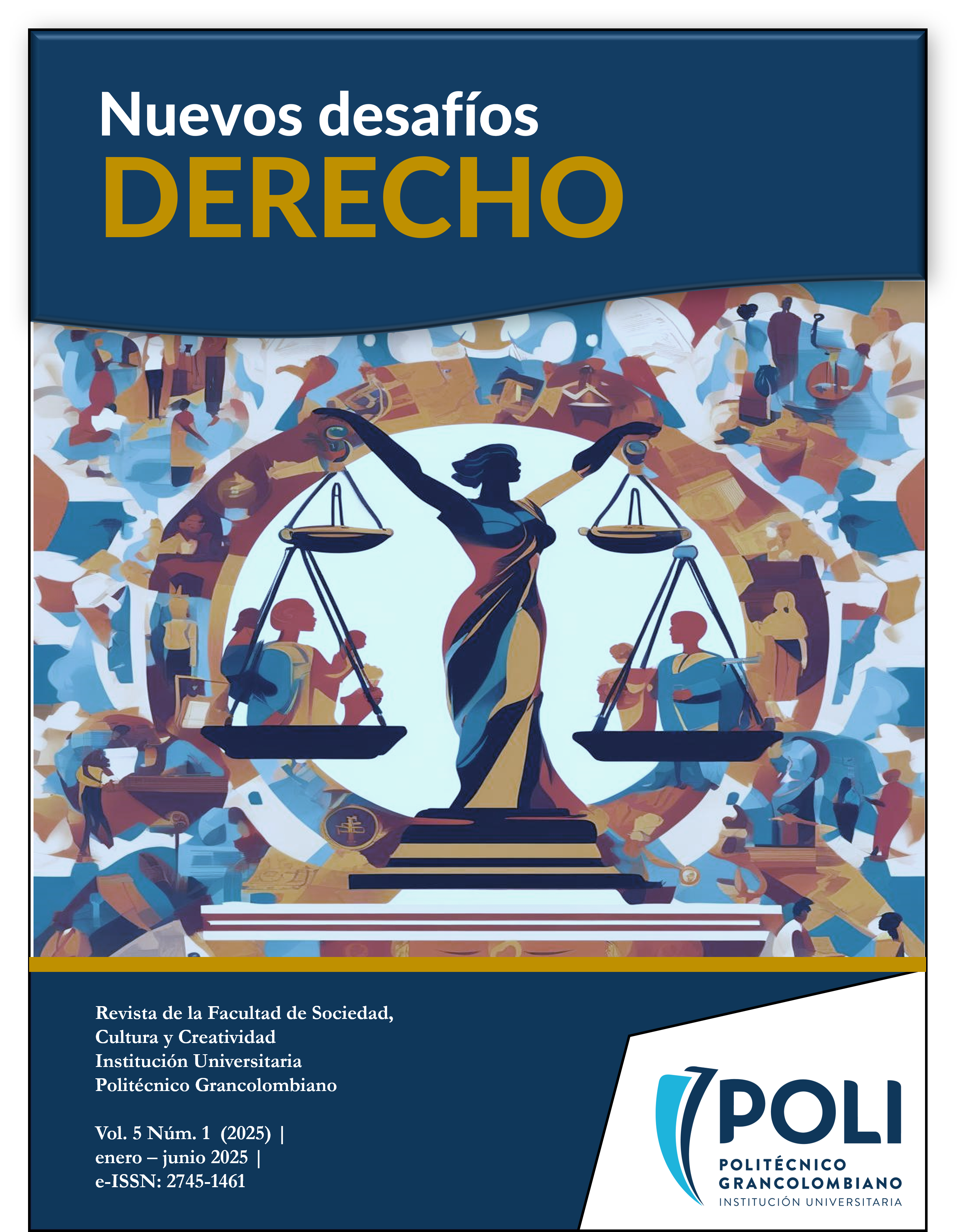Abstract
Grooming is a crime that involves the manipulation and seduction of children and adolescents through the Internet with the aim of gaining their trust and sexually exploiting them. The purpose of this article is to explain what grooming is, its modalities, who are the participants and what is how the behavior materializes; Therefore, this document is the product of an exploratory and descriptive investigation, which used documentary analysis as a collection technique. Therefore, it is explained that they were able to identify deficiencies in the national legal system as a result of the passivity of the Colombian state by not recognizing a denomination of the unlawful act, which generates an impossibility of carrying out measurements, so that the punishable is not identifiable as a risk of social impact on infants, it is so, that the reports issued by the judicial entities do not show the real proportion of its materialization, making it impossible to propose public policies to reduce the affectation of the rights of minors and the identification of the areas geographic regions of the country with the highest occurrence. The contribution of this article is the awareness that the first line of defense to protect minors from computerized pedophiles or groomers is in the criminal classification of the act, to define national policies that allow the uniform sanction of the active subjects, segment their modalities of action, initiate aggressive campaigns by judicial entities in the areas of greatest occurrence and advance national awareness actions with clear models of care for victims.
References
Agudelo, A. P., Bravo, G., & Guevara Villabón, C. (2017). https://www.camara.gov.co/. Obtenido de https://www.camara.gov.co/sites/default/files/2017-08/P.L.050-2017C%20%28DELITOS%20CIBERNETICOS%29.pdf
Barrios Achavar, V., & Vargas Cardenas, A. (2018). Convenio sobre la Ciberdelincuencia: Convenio de Budapest. Asesoría Tecnica PArlamentaria, 1-12.
Bergen, E., Davidson, J., Schulz, A., Schuhmann, P., Johansson, A., Santtila, P., y Jern, P. (2014). The effects of using identity deception and suggesting secrecy on the outcomes of adult-adult and adult-child or adolescent online sexual interactions. Victims & Offenders, 9(3), 276-298. https://doi.org/10.1080/15564886.201 3.873750
Centro Internacional para Niños Desaparecidos y Explotados (ICMEC). (2017). Grooming por Internet de Niños, Niñas, y Adolescentes con fines Sexuales: Modelo de Legislación y Revisión Global. Grooming por Internet de Niños, Niñas, y Adolescentes con fines Sexuales: Modelo de Legislación y Revisión Global. 55 https://www.icmec.org/wp-content/uploads/2017/09/Grooming-Por-Internet-de-Ninos_ FINAL_9-18-17_ES_FINAL.pdf
Congreso de Colombia. (24 de 07 de 2018). Ley 1928, http://www.secretariasenado.gov.co/. Obtenido de http://www.secretariasenado.gov.co/senado/basedoc/ley_1928_2018.html
Consejo de Europa. (2001). Convenio de Budapest. Budapest: Serie de tratados Europeos.
Escobar, N. (19 de 05 de 2015). Qué es el grooming y cómo podemos proteger a los niños en Internet
https://hipertextual.com/. Obtenido de https://hipertextual.com/2015/05/que-es-el-grooming
ESET. (2020). https://acis.org.co. Obtenido de https://acis.org.co/portal/content/noticiasdelsector/grooming-una-problem%C3%A1tica-que-crece-durante la cuarentena#:~:text=La%20hiperconectividad%20aumenta%20el%20riesgo,de%20grooming%20durante%20la%20cuarentena.&text=M%C3%A1s%20all%C3%A1%20de%20este%20c
Espina-Romero, L. C. (2022). Procesos de Enseñanza-Aprendizaje Virtual durante la COVID-19: Una revisión bibliométrica. Revista de Ciencias Sociales (Ve), XXVIII (3), 345- 361. https://doi.org/10.31876/rcs. v28i3.38479
Gruchel, N., Kurock, R., Bonanati, S., y Buhl, H. M. (2022). Parental involvement and Children’s internet uses - Relationship with parental role construction, selfefficacy, internet skills, and parental instruction. Computers & Education ,182(C). https://doi.org/10.1016/j. compedu.2022.104481
CEPAL, UNICEF, y Oficina de la Representante Especial del secretario general sobre la Violencia contra los Niños. (2020). Violencia contra niñas, niños y adolescentes en tiempos de COVID-191. Repositorio Cepal. https://repositorio.cepal.org/bitstream/handle/11362/46485/1/S2000611_es.pdf
Falestchi, D. (11 de 11 de 2020). iab Colombia. Obtenido de El desconocimiento, la silenciosa complicidad y el avance del grooming en América Latina: https://www.iabcolombia.com/el-desconocimiento-la-silenciosa-complicidad-y-el-avance-del-grooming-en-america-latina/
Florez, J. (2020). https://www.muyinteresante.es/. Obtenido de https://www.muyinteresante.es/curiosidades/preguntas-respuestas/ique-es-el-grooming#:~:text=El%20t%C3%A9rmino%20proviene%20del%20ingl%C3%A9s,cepillar%20en%20caso%20de%20animales
Guillén, J., Guillén, E. S., Mosquera, M. A., y Muñoz, N. (2022). Desarrollo de actividades escolares y redes sociales en pandemia: Una mirada desde la percepción de estudiantes. Revista de Ciencias Sociales (Ve), XXVIII (4), 400-414. https://doi.org/10.31876/rcs.
Ibáñez-Ayuso, M. J., Limón, M. R., y Ruiz Alberdi, C. M. (2022). Retos virales: Análisis del impacto de TikTok para los vínculos familiares. Revista de Ciencias Sociales (Ve), XXVIII(3), 42-54. https://doi.org/10.31876/rcs. v28i3.38449
Lykousas, N., y Patsakis, C. (2021). Largescale analysis of grooming in modern social networks. Expert Systems with Applications, 176, 114808. https://doi. org/10.1016/j.eswa.2021.114808
Méndez, L, y Pérez, F. (11 de diciembre de 2020). El grooming como factor de impacto en tiempo de pandemia. Diario La Ley, (9752).
Mendoza, M. A. (16 de Febrero de 2016). www.welivesecurity.com. Obtenido de https://www.welivesecurity.com/la-es/2016/02/16/grooming-riesgo-menores-internet/
O’Connell, R. (2003). A typology of cyber sexploitation and online grooming practices. Cyberspace Research Unit, University of Central Lancashire. http://image.guardian.co.uk/sysfiles/Society/documents/2003/07/24/ Netpaedoreport.pdf
Pérez Porto, J., & Merino, M. (2020). Definicion.de. Obtenido de https://definicion.de/grooming/
Policia Nacional. (02 de 2021). www.policia.gov.co/. Obtenido de https://www.policia.gov.co/grupo-informaci%C3%B3n-criminalidad/estadistica-delictiva
Reyns, B.W., Burek, M.W., Henson, B., & Fisher, B.S. (2013). The unintended consequences of digital technology: Exploring the relationship between sexting and cybervictimization. Journal of Crime and Justice, 36(1), 1-17. doi: 10.1080/ 0735648X.2011.641816.
Rezaee, P., Raja, K., y Bours, P. (2023). Online grooming detection: A comprehensive survey of child exploitation in chat logs. Knowledge-Based Systems, 259, 110039. https://doi.org/10.1016/j. knosys.2022.110039
Veschi, B. (2019). ETIMOLOGIA, Origen de la Palabra. Obtenido de https://etimologia.com/grooming/

This work is licensed under a Creative Commons Attribution-NonCommercial-NoDerivatives 4.0 International License.
Copyright (c) 2024 Nuevos desafíos del Derecho


